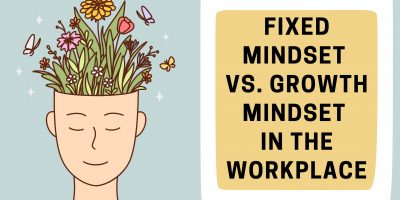
Fixed Mindset vs. Growth Mindset in the Workplace
Understand the key differences between a fixed and a growth mindset to foster a culture of development and adaptability at work.


MA, Registered Psychotherapist, & Yoga Therapist Trainer

Co-Founder at WorkWelle
While its essence remains the same, the wellness concept is constantly evolving.
From the ancient Ayurvedic regimen of “harmony between body, mind, and soul” to 19th-century intellectual and medical movements to today’s modern approach, wellness has always been a multi-layered process that strives to balance all areas of life.
Naturally, as our needs change in an increasingly complex and fast-paced world, so do their dimensions and practices.
Now that we have better access to information and technology, increasing awareness, and a growing recognition of its importance, wellness has gone mainstream. It’s no longer a niche pursuit but a fundamental aspect of everyday life, influencing personal choices, healthcare practices, and workplace policies.
Focusing on the latter, we did a comprehensive overview of the modern wellness concept by examining its eight dimensions and their influence on the workplace, employee well-being, and organizational success.
So, what is wellness, and what does it entail from a modern-day perspective?
The Global Wellness Institute (GWI) defines it as “an active pursuit of activities, choices, and lifestyles that lead to a state of holistic health.”
Not to be confused with healthcare, which is reactive and focuses on diagnosis, treatment, and cure, the wellness concept is broader, proactive, and preventative. This means it’s driven by a person’s self-responsibility to maintain a healthy lifestyle and achieve greater well-being.
In fact, if we look at health as a continuum from illness to optimal well-being, healthcare stands at one end, which GWI defines as the Medical Paradigm or our periodical and reactive approach to health. On the opposite end is the Wellness Paradigm, or proactively increasing the quality of health through positive habits.
In other words, wellness is not just the absence of illness.
On the contrary, it’s the process of living life to its fullest potential. That’s why we shouldn’t look at the wellness concept solely from the perspective of physical well-being but as a holistic approach that encompasses various dimensions of a person’s life, from mental and emotional to social and even spiritual.
As such, wellness has permeated every facet of society, extending its influence on the modern workplace.

Although the wellness concept has ancient roots, its modern adoption has become a corporate buzzword in the past few decades.
Statistics show that nine in ten organizations offer at least one wellness incentive, while 64% plan to invest more in these benefits.
As employee wellness becomes an irreplaceable part of the workplace, ongoing research reinforces its significance. The following statistics are just a few examples that underscore its vital role in employee well-being:
Research has repeatedly shown that wellness is of the utmost importance in today’s workplace, influencing individual well-being and organizational success. A healthy employee is a happy one, which means they’re better equipped to handle work-related challenges, leading to greater productivity, loyalty, and retention.
However, wellness is not a singular entity but rather a merger of dimensions and practices, each requiring a different approach. Thus, to fully understand it in and out of the workplace, we must examine all dimensions separately before considering the wellness concept as a workplace asset.
“The different dimensions of wellness have been described in ancient traditions and remain relevant in modern medicine today by way of the biopsychosocial-spiritual model,” illustrates Erin Byron, MA, Registered Psychotherapist, and Yoga Therapist Trainer.
“We can think of them as being in body, energy, emotions, state of mind, and spirit.
Thinking of it from the bottom up, how we treat our bodies through rest, nutrition, play, effort, and movement affects our energy levels, emotions, the way we think and perceive, and also our sense of connection to who we are.
Getting support on any of those wellness dimensions, whether professional support from a holistic health provider, a mental health practitioner or simply joining a book club or associating with people we enjoy, these practical habits and hobbies support our overall whole-person well-being,” Byron concludes.
So, where and how does the workplace fit into this narrative?
Since the average person spends up to 90,000 hours on the job, work becomes another important setting for health protection and promotion. It involves addressing physical concerns within the work environment, leveraging wellness resources, and actively engaging the workforce with different initiatives.
As a result, wellness programs have emerged as tools for promoting employee well-being, covering different or all dimensions of the wellness concept.
Below, we explore each dimension separately, how they affect employee wellness, and how employers can promote them in the workplace.

What it means: Maintaining positive physical health.
How to achieve: Through fitness, nutrition, sleep, weight management, smoking cessation, and preventative healthcare.
Physical health is the most common association with the wellness concept. However, contrary to popular belief, this is only one of its eight dimensions, encompassing fitness, nutrition, sleep, illness prevention, and chronic condition management.
In the workplace, this dimension and all its subcategories play a significant role in reaching and maintaining a healthier, more productive, and engaged workforce.
In fact, studies examining workplace wellness programs based on physical activity show that they can boost workability and health, including cardiorespiratory fitness, muscle strength, and musculoskeletal symptoms.
However, beyond fitness or exercise, it’s important to note that enhancing physical wellness can involve anything from better access to healthcare to investing in wellness providers that manage different aspects of employee health.
For example, fitness-focused provider Aaptiv offers personalized digital fitness and robust gym networks. On the other hand, vendors like BetterYou and 2Morrow Inc. offer a more comprehensive suite of wellness solutions, including sleep programs and smoking cessation. Applied Health Analytics, as another example, focuses on integrating data-driven health insights to personalize employee wellness programs and enhance overall health outcomes.
While all these have unique advantages, a company’s approach to physical health, or the initiative it chooses, ultimately depends on its business objectives and, more importantly, employee needs.
What it means: Maintaining good cognitive functioning and psychological well-being.
How to achieve: Through easy access to mental healthcare, counseling, and stress management.
Mental well-being is just as important as physical well-being. Fortunately, after years of stigma, the conversation about mental health is expanding, bringing forth awareness and better solutions for achieving mental wellness in all aspects of life.
In other words, we now have better resources to tackle stress, anxiety, depression, and other mental conditions.
This also explains the increase in investment in mental health benefits.
According to Wellable’s report, these benefits were the “rising star” of 2023 with 91%, followed by stress management and resilience (77%) and mindfulness and meditation (74%). The research also shows that EAPs were the most popular solution, and there was also interest in digital health solutions and educational resources on mental health.
As interest rises, providers like Wellworks For You, Aduro, and Wellness Coach have become excellent examples of how including mental health resources complements a comprehensive wellness strategy.
Whether it’s through clinical mental health support and EAPs (Wellness Coach), expert coaching and leadership training (Aduro), or challenges, courses, and mental health tools (Wellworks for You), mental wellness can empower employees and contribute to their overall health and well-being.

What it means: Understanding and managing individual emotions, values, and attitudes.
How to achieve: By practicing mindfulness and learning healthy coping mechanisms.
Although sometimes used synonymously, mental and emotional well-being are two dimensions of the wellness concept. The latter represents emotion management, maintaining a positive outlook on life, and developing healthy relationships.
“We know from studies on the brain and the nervous system, as well as studies on social engagement and just plain old having fun, that our mental and emotional well-being play a huge role in the context of overall wellness,” explains Erin Byron.
“If we’re not feeling good in our hearts or our minds, it is unlikely that we’ll be able to feel good in our bodies.
What we now know about chronic conditions like persistent pain, migraine, irritable bowel, and many autoimmune conditions is that when we feel poorly about ourselves when we aren’t enjoying our lives and social engagements, we experience worse health symptoms,” she concludes.
Between its benefits and its effect on other aspects of health, emotional wellness is gaining more traction, especially among younger workers.
Research by Willis Towers Watson shows that employees born after 1995 want more support in managing their emotional health.
For employers, that means creating a supportive and inclusive environment where their workers feel valued, respected, and appreciated.
How they achieve this can overlap with other practices mentioned throughout this article.
For Clara Emanuel, Co-Founder at WorkWelle, “Emotional resilience is an armor against the unpredictable tides of work, society, and family life. It’s about nurturing a robust inner life that helps you handle stress, overcome obstacles, and bounce back stronger from setbacks.”
“Emotional resilience can look like setting boundaries at work to communicate limits or reset during difficult times,” Emanuele illustrates.
Other methods include EAPs for emotional support, team-building activities for social connections, conflict resolution programs, etc.
Wellness platforms like Empathy further strengthen employees’ emotional wellness by providing dedicated grief support, personal care plans, and solutions and guidance that address unique and personal challenges.

What it means: Finding purpose, value, and meaning in life.
How to achieve: By participating in activities that align with one’s beliefs and values.
The Laborers’ Health and Safety Fund of North America (LHSFNA) defines spiritual wellness as “being connected to something greater than yourself and having a set of values, principles, morals, and beliefs that provide a sense of purpose and meaning to life, then using those principles to guide your actions.”
This dimension may or may not involve religious activities. Regardless, employees should have opportunities to practice their spirituality without interference or conflict from their employers.
In return, companies get spiritually “healthy” employees who are typically more focused, communicative, and engaged. These workers possess a sense of purpose and confidence, enabling them to concentrate on work. They are also open about their needs when they feel their beliefs are respected.
According to Stride Mental Health, the benefits of spiritual wellness may also influence physical health through better stress and anxiety management and the development of healthier habits.
So, the question is – what can companies do to support it?
The answer depends on the demographic and employee needs. However, it all comes down to creating a safe environment for all workers, encouraging diversity, and actively supporting an inclusive workplace.
This approach not only supports spiritual wellness but makes the workplace a safe space for all employees, built on compassion and respect.
What it means: Developing and maintaining healthy relationships.
How to achieve: By participating in social activities and contributing to the community.
Social wellness is a tremendous part of our lives as social beings who rely heavily on our relationships and the sense of belonging we get from them. This dimension is even more crucial now, amid a loneliness epidemic.
According to Cigna, loneliness rates have doubled in the last four decades, affecting 58% of US adults and 79% of young adults.
The COVID-19 pandemic has further exacerbated this issue by forcing many employees to work remotely, isolating them from their colleagues and disrupting social interactions.
As a result, we are seeing heightened emotional distress, as well as a decline in mental health (31%) and physical health (12%), emphasizing the need for preventative measures in and out of the workplace.
Highlighting how social habits can improve mental and physical health, the National Institutes of Health cites six strategies in their social wellness kit that can help achieve this:
If we expand the solutions to the workplace, online platforms, mentorship programs, peer support networks, and team-building events are all a great way to challenge the loneliness epidemic and reaffirm the workplace’s significance as a social hub. Moreover, some wellness providers, such as Yumuuv, offer programs that support team challenges and encourage social connections.
As we conclude this dimension of wellness and move on to the next one, it’s important to point out that better social connections can influence business success beyond employee wellness. Research shows that 57% of workers agree that having a good work friend makes their job more enjoyable, 24% are more productive, and 15% are less likely to leave their employer.

What it means: Maintaining a healthy, safe, and sustainable environment that supports well-being.
How to achieve: By raising awareness and demonstrating a commitment to improving the environment.
Environmental wellness involves creating and maintaining a living and working space that promotes good health, safety, and sustainability. Although this dimension does not get the same attention as the others, it’s still an inseparable part of the wellness concept and our lives.
From a workplace perspective, a healthy and environmentally friendly space can reduce the risk of illnesses, injuries, and even stress, enhancing employee wellness. Moreover, ensuring clean air, ergonomic furniture, and safety measures creates a comfortable and secure environment for everyone.
Unfortunately, while many are privileged to enjoy environmental wellness, at least to some extent, unhealthy environments still contribute to 12 million deaths globally each year.
Therefore, employer-supported programs, such as recycling, sustainable practices, or energy-efficient initiatives, not only bring a sense of purpose and community among workers but also raise awareness, contribute to a healthier environment, and benefit the planet.
What it means: Finding satisfaction and fulfillment in your work.
How to achieve: Through realistic goals, self-care, work-life balance, and professional development opportunities.
Occupational wellness refers to the satisfaction, fulfillment, and balance a person achieves in their work. It involves finding individual and professional growth opportunities, maintaining a healthy work-life balance, and feeling valued and recognized in the workplace.
Unlike the other aspects of wellness we explored, this one directly links to employee well-being since it aligns a person’s career with their values, skills, and interests, fostering a sense of purpose and achievement.
Employers play a pivotal role in this.
By prioritizing this dimension of the wellness concept, they can create an environment where workers thrive personally and professionally, ultimately leading to a happier and more productive workforce.
In fact, the Qualtrics 2023 Global EX Trends report finds a connection between occupational wellness, employee engagement, and loyalty. According to the data, workers who felt their organization embodied their values were 27% more likely to exhibit higher engagement and 23% more likely to stay loyal to their employer in the next three years or more.
Some of the best examples of how companies can support occupational wellness include flexible work arrangements, professional development opportunities, and access to wellness providers like Navigate Wellbeing Solutions and WellRight, which specifically offer programs and resources for occupational well-being.
What it means: Growing intellectually and expanding one’s knowledge and skills.
How to achieve: By engaging in stimulating activities that expand knowledge, creativity, and critical thinking.
Intellectual wellness, the last piece of the puzzle, refers to the active pursuit of knowledge, creativity, and mental growth. It involves stimulating activities that challenge the mind and expand a person’s skills.
In the workplace, this translates to critical thinking, problem-solving, and exploring new ideas and perspectives. Employees who engage in activities like learning new skills or pursuing educational opportunities stimulate their minds and expand their knowledge, leading to greater job performance.
However, while learning and upgrading is a personal choice, the employer is responsible for ensuring workers have the means to do so.
For example, they can provide educational resources, organize workshops and training programs, or invest in providers that support intellectual wellness. One such provider is BSDI, which offers challenges encouraging employees to learn something new as part of its wellness program.

Gallup shows that only 33% of the US and 23% of the global workforce was engaged last year. Although these numbers show a slight improvement from previous years, they remain concerningly low.
Yet, as we explored the importance of employee well-being, we saw that wellness programs, as a successful approach to holistic wellness at work, positively impact job satisfaction, motivation, loyalty, and morale.
They also contributed to lower costs and absenteeism.
From here, it’s safe to assume that workers who are happy, healthy, and motivated are also more likely to be engaged.
The interconnectedness of all wellness dimensions is evident here, as is their individual influence on employee and organizational well-being. How workers think, feel, and act is often defined by their employer’s willingness to invest in their well-being and the lengths they’ll go to ensure what’s in the workers’ best interest.
Therefore, understanding the wellness concept and implementing the right wellness program may not be the only solution to low engagement, but it’s certainly a move in the right direction.
Disclosure: Some of the products featured in this blog post may come from our partners who compensate us. This might influence the selection of products we feature and their placement and presentation on the page. However, it does not impact our evaluations; our opinions are our own. The information provided in this post is for general informational purposes only.
Content Writer at Shortlister
Browse our curated list of vendors to find the best solution for your needs.

Understand the key differences between a fixed and a growth mindset to foster a culture of development and adaptability at work.

Uncover the importance of a well-planned and thoughtfully allocated wellness program budget that meets your organization’s needs.

Dive into the latest sleep statistics and uncover the impact of quality sleep on wellness, mental health, and daily functioning.

As the wellness landscape is growing, make a strategic move that can significantly impact employee well-being and organizational success by integrating wellness programs into existing employee benefits.
Used by most of the top employee benefits consultants in the US, Shortlister is where you can find, research and select HR and benefits vendors for your clients.
Shortlister helps you reach your ideal prospects. Claim your free account to control your message and receive employer, consultant and health plan leads.